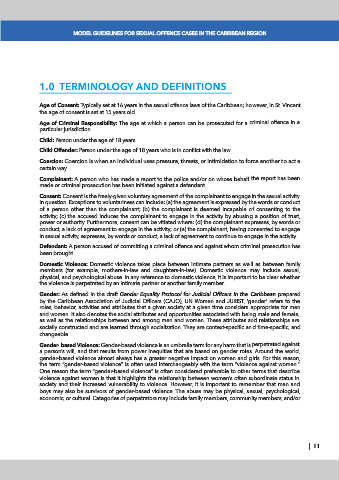Page 610 - Magistrates Conference 2019
P. 610
MODEL GUIDELINES FOR SEXUAL OFFENCE CASES IN THE CARIBBEAN REGION
1.0 TERMINOLOGY AND DEFINITIONS
Age of Consent: Typically set at 16 years in the sexual offence laws of the Caribbean; however, in St. Vincent
the age of consent is set at 15 years old.
Age of Criminal Responsibility: The age at which a person can be prosecuted for a criminal offence in a
particular jurisdiction.
Child: Person under the age of 18 years.
Child Offender: Person under the age of 18 years who is in conflict with the law.
Coercion: Coercion is when an individual uses pressure, threats, or intimidation to force another to act a
certain way.
Complainant: A person who has made a report to the police and/or on whose behalf the report has been
made or criminal prosecution has been initiated against a defendant.
Consent: Consent is the freely-given voluntary agreement of the complainant to engage in the sexual activity
in question. Exceptions to voluntariness can include: (a) the agreement is expressed by the words or conduct
of a person other than the complainant; (b) the complainant is deemed incapable of consenting to the
activity; (c) the accused induces the complainant to engage in the activity by abusing a position of trust,
power or authority. Furthermore, consent can be vitiated where: (d) the complainant expresses, by words or
conduct, a lack of agreement to engage in the activity; or (e) the complainant, having consented to engage
in sexual activity, expresses, by words or conduct, a lack of agreement to continue to engage in the activity.
Defendant: A person accused of committing a criminal offence and against whom criminal prosecution has
been brought.
Domestic Violence: Domestic violence takes place between intimate partners as well as between family
members (for example, mothers-in-law and daughters-in-law). Domestic violence may include sexual,
physical, and psychological abuse. In any reference to domestic violence, it is important to be clear whether
the violence is perpetrated by an intimate partner or another family member.
Gender: As defined in the draft Gender Equality Protocol for Judicial Officers in the Caribbean prepared
by the Caribbean Association of Judicial Officers (CAJO), UN Women and JURIST, ‘gender’ refers to the
roles, behavior, activities and attributes that a given society at a given time considers appropriate for men
and women. It also denotes the social attributes and opportunities associated with being male and female,
as well as the relationships between and among men and women. These attributes and relationships are
socially constructed and are learned through socialization. They are context-specific and time-specific, and
changeable.
Gender- based Violence: Gender-based violence is an umbrella term for any harm that is perpetrated against
a person’s will, and that results from power inequities that are based on gender roles. Around the world,
gender-based violence almost always has a greater negative impact on women and girls. For this reason,
the term “gender-based violence” is often used interchangeably with the term “violence against women.”
One reason the term “gender-based violence” is often considered preferable to other terms that describe
violence against women is that it highlights the relationship between women’s often subordinate status in
society and their increased vulnerability to violence. However, it is important to remember that men and
boys may also be survivors of gender-based violence. The abuse may be physical, sexual, psychological,
economic, or cultural. Categories of perpetrators may include family members, community members, and/or
| 11

